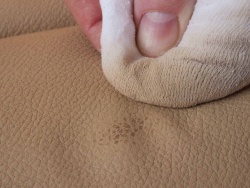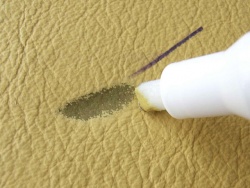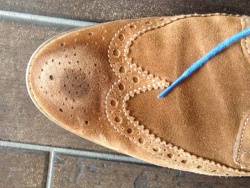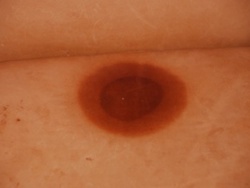Difference between revisions of "Leather care instructions - Home remedies"
| Line 9: | Line 9: | ||
| − | In | + | In magazines and on the Internet, leather care tips always appear, where home remedies are the solution to [[leather care]] problems. In most cases, the recommended agents are based on plant or animal substances. Usually the reason for these leather tips is the desire for frugality. |
| − | [[ | + | [[Leather care]] is used to carry on a preservation process ([[tanning leather|tanning]]). If [[leather]] is treated with perishable products, these will corrode on the leather surface or in the leather and will accelerate [[leather damages|decay]]. Therefore, leather care products themselves are protected from deterioration by preservatives, so that the leather is not damaged accelerated. Leather care tips based on perishable and non-conserved products do not meet this requirement. |
| − | == | + | ==Collection and review of the most common leather care tips== |
| − | * | + | * For cleaning leather you can use a mixture of '''degreased milk''' and water. Assessment: milk becomes rancid! |
| − | * | + | * Leather can be cleaned with '''cut potatoes'''. Assessment: A damp cloth does same and does not leave potato juice remnants! |
| − | * | + | * Water stains on shoes can be removed with '''sliced onions'''. Assessment: As with the potato, a damp cloth is enough and does not smell of onion! |
| − | * ''' | + | * '''Banana peel'''' is suitable as a leather care. The leather is smooth and shiny. Assessment: banana residues are also corrosive and do not give the necessary refatting, and the smell changes after some time! |
| − | * | + | * Fresh grease stains can be removed by instant rubbing with a little '''beaten egg whites'''. Assessment: A damp cloth or cleaning spirit is more effective and does not leave its own film. |
| − | + | ||
| − | + | ==[[Basic rules when dealing with leather]]== | |
| − | [[ | + | There are [[basic rules when dealing with leather]]. Usually, the mistakes are made during [[Leather cleaner|cleaning attempts]]. But also wrong chosen care products for the [[Types of leather|type of leather]] can lead to undesirable results. Therefore, always first determine the [[Types of leather|type of leather]] and first test all cleaning or maintenance attempts in a hidden area for undesired changes. |
| − | + | ||
| − | + | ||
| − | [[ | + | |
| − | [[ | + | |
| − | + | ||
| − | + | ||
| − | + | ||
| − | + | ||
| − | + | [[finish|Surface-pigmented]] smooth leather can usually be treated with leather cleaners and leather care products. When too long and too hard rubbing, the leather colour layer can be dissolved. Also, solvent-containing products damage the leather. | |
| − | + | ||
| − | + | ||
| − | + | ||
| − | + | ||
| Line 46: | Line 33: | ||
</p> | </p> | ||
<p align=center> | <p align=center> | ||
| − | '' | + | ''Solvent-containing products or excessive rubbing can damage the [[finish]].''<br></p> |
<p> </p> | <p> </p> | ||
| − | + | Most mistakes are made when cleaning and caring of [[Porous leather|open-pored]] aniline leather, [[suede]] or [[nubuck]]. With these leathers, you have to be very careful to not increase the damage by a wrong cleaning methods. Water is often sufficient to enlarge the stain. Always test with leather, if rubbed fluids enter and darken. If this is the case, special caution is advised. | |
| − | + | ||
| − | + | ||
| − | + | IMPORTANT: Test all applications in a hidden area! If in doubt, reproduce the damage where it is not visible and try to clean it first there. | |
| Line 75: | Line 60: | ||
| − | == Tips for [[leather cleaner|leather cleaning]], [[leather repairs]] and [[leather care]] == | + | == Tips for [[leather cleaner|leather cleaning]], [[Leather repair|leather repairs]] and [[leather care]] == |
[[bild:Colourlock-02.jpg|16px]] -> [https://www.colourlock.com COLOURLOCK - Leather Care Products] | [[bild:Colourlock-02.jpg|16px]] -> [https://www.colourlock.com COLOURLOCK - Leather Care Products] | ||
<br> | <br> | ||
Revision as of 16:41, 28 January 2017
In magazines and on the Internet, leather care tips always appear, where home remedies are the solution to leather care problems. In most cases, the recommended agents are based on plant or animal substances. Usually the reason for these leather tips is the desire for frugality.
Leather care is used to carry on a preservation process (tanning). If leather is treated with perishable products, these will corrode on the leather surface or in the leather and will accelerate decay. Therefore, leather care products themselves are protected from deterioration by preservatives, so that the leather is not damaged accelerated. Leather care tips based on perishable and non-conserved products do not meet this requirement.
Contents
Collection and review of the most common leather care tips
- For cleaning leather you can use a mixture of degreased milk and water. Assessment: milk becomes rancid!
- Leather can be cleaned with cut potatoes. Assessment: A damp cloth does same and does not leave potato juice remnants!
- Water stains on shoes can be removed with sliced onions. Assessment: As with the potato, a damp cloth is enough and does not smell of onion!
- Banana peel' is suitable as a leather care. The leather is smooth and shiny. Assessment: banana residues are also corrosive and do not give the necessary refatting, and the smell changes after some time!
- Fresh grease stains can be removed by instant rubbing with a little beaten egg whites. Assessment: A damp cloth or cleaning spirit is more effective and does not leave its own film.
Basic rules when dealing with leather
There are basic rules when dealing with leather. Usually, the mistakes are made during cleaning attempts. But also wrong chosen care products for the type of leather can lead to undesirable results. Therefore, always first determine the type of leather and first test all cleaning or maintenance attempts in a hidden area for undesired changes.
Surface-pigmented smooth leather can usually be treated with leather cleaners and leather care products. When too long and too hard rubbing, the leather colour layer can be dissolved. Also, solvent-containing products damage the leather.
Solvent-containing products or excessive rubbing can damage the finish.
Most mistakes are made when cleaning and caring of open-pored aniline leather, suede or nubuck. With these leathers, you have to be very careful to not increase the damage by a wrong cleaning methods. Water is often sufficient to enlarge the stain. Always test with leather, if rubbed fluids enter and darken. If this is the case, special caution is advised.
IMPORTANT: Test all applications in a hidden area! If in doubt, reproduce the damage where it is not visible and try to clean it first there.
Improper cleaning attempts often increase the stains. Depending on the wrong method, the spots get light or dark edges.
Additional information
- Leather care
- Leather cleaner
- Basic rules when dealing with leather
- Ecological leather care - Eco leather care
- Leather damages
Tips for leather cleaning, leather repairs and leather care
![]() -> COLOURLOCK - Leather Care Products
-> COLOURLOCK - Leather Care Products
![]() -> In German: www.lederzentrum.de
-> In German: www.lederzentrum.de
![]() -> Rest of the world: partners worldwide
-> Rest of the world: partners worldwide












 a kotori web solution
a kotori web solution